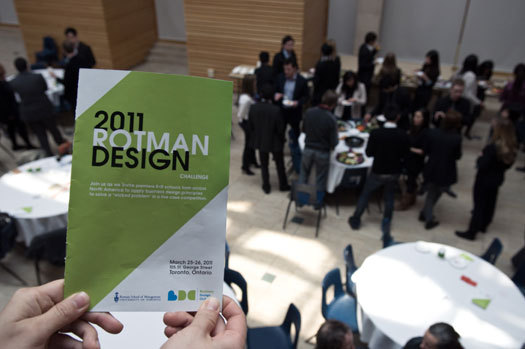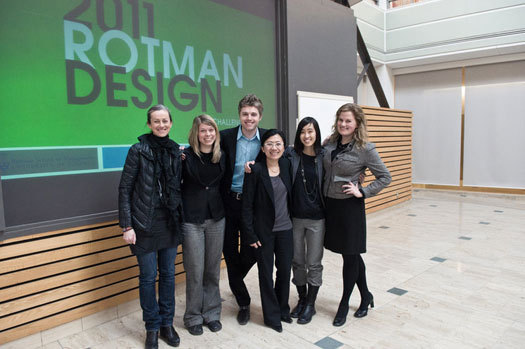
Photo: Rotman
In recent years, calls for a more creative or innovative approach to, well, pretty much everything but our financial instruments, have become more pointed. As the western economy in particular has evolved away from its industrial roots and as the Internet has wrought digital havoc on the old, understood ways of doing things, so have many accepted that the education of those who will effectively lead progress toward a healthy, sustainable future must also shift — and fast.
As such, multiple experiments have sprung up at both business and design schools, each one aiming to produce hybrid thinkers who can span both worlds in order to create a better, brighter future for us all.
One such initiative took place recently at Rotman School of Management, part of the University of Toronto. Students and members of the school's Business Design Club organized the second annual Rotman Design Challenge, held in a vast space in the heart of campus over the weekend of March 25th.
And so it was that a motley assortment of 19 teams from master’s and MBA students from design and business schools around North America collected in a bitterly cold Toronto to battle for the $1500 first prize. The weekend was the culmination of three weeks work the students had already put in on a challenge set by the Center for Innovation at the Mayo Clinic in conjunction with the innovation consultancy Doblin, part of the Monitor Group*. As with so many innovation briefs, the requirements were somewhat open-ended: “Develop a new offering targeted at a specific patient population that will enable that population to improve their prospects for a healthy future,” it read.
(*Full disclosure: I was part of the BusinessWeek team that put together the 2009 list of schools from which students were invited to take part. I’m also currently working for Doblin, which was one of the event’s main sponsors. So I was doubly interested in the contest and yet, I’d argue, more than able to retain my critical eye.)
So how was it? Well, somewhat predictable. The students from design schools rocked the visual and storytelling angles of their presentations yet all too often seemed somewhat hazy on how they might create a viable business from their idea. The pure MBA students, in contrast, were stronger when articulating issues related to, say, business model but had a notably weaker grasp of the user-centered nature of the challenge. Interestingly, three of the top four teams were from design schools (California College of Arts and the University of Cincinnati placed second and third, with a team from Rotman in fourth place.)

OCAD winning team: Winning team from OCAD University, pictured with Mayo Clinic's Lorna Ross (left). Photo: Rotman
The winning team hailed from the Ontario College of Art and Design University (OCADU). The group of five had shown chutzpah right from the start, when they heard about the competition on the Toronto grapevine and promptly demanded to be allowed to take part. (OCADU didn’t feature on BusinessWeek’s list last year.)
All studying for a Masters in Strategic Foresight and Innovation, the five students came up with an initiative aimed at breastfeeding mothers. Overlooking the intense emotions so often sparked by the topic of breastfeeding, the project envisioned Mayo as a facilitator, not a provider of healthcare per se. By certifying women who’d previously breastfed successfully as “Mayo Moms” and partnering them with mothers-to-be within the community, the students both leveraged Mayo’s brand and pointed to the creation of a potentially limitless social network.
“I loved the Mayo Moms because the project imagined a relationship with Mayo outside of the traditional physician/patient dynamic to one of a relationship directly with the brand,” commented Lorna Ross, design manager at Mayo’s Center for Innovation, who gave a keynote speech on the increasingly important role design can play in healthcare and who acted as one of the day’s judges. “It was a way of meeting the user/customer/patient in a new space and a new conversation and a new relationship. I think this is exactly what Mayo needs in order to remain relevant.”
Not all of the submissions were successful, and many showed only a superficial understanding of either design or business. I suppose that’s to be expected. A genuinely interdisciplinary educational track, which truly marries business and design rather than tacking one loosely onto the other, is yet to be realized anywhere. Nonetheless, programs such as those on offer at the schools represented here are at least making an effort, and the students themselves were refreshingly committed, passionate and energetic.
“In the past, MBAs did well because of the hierarchical structure of organizations and their ability to make process improvements,” said Jen Chow of the winning OCADU team, who initially got her master’s in accounting before going back last fall to study for the more creative master’s degree. “Design offers new perspective on how to offer relevant products and services, so I think it makes plenty of sense that MBA schools are integrating more design processes into their problem solving. Also, the two are so necessarily interdisciplinary, so it's about time they intermingle.”
About time is right, and a major concern must be the slow rate and small scale of such experiments. In 2008, the last year for which statistics are available, 25% of the 625,000 master’s degrees awarded were in business. There’s no analysis of how or how much generative skills or the practice of design thinking factor into these degrees, but it’s clear the MBA machine continues to churn out new products in a way that would make a Victorian factory owner proud. Design, for what its worth, didn’t even warrant its own field on the table.
But as educators continue to try and figure out how best to serve those who will help forge our collective future, it’s worth remembering one of the successful tenets of innovation: try, fail, try something else, fail again, try again. “There’s no playbook here. We’re all doing it for the first time,” said Mayo’s Ross. “What you really want from someone is the ability to project, 'I don’t know how to do that but I know I can do it’.” That’s a philosophy worth adopting in all parts of life.
